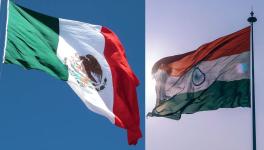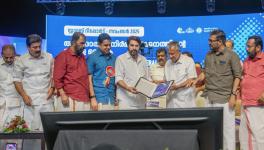Indian Diplomacy in Overstretch
G7 Summit leaders at “working lunch” session, Japan, 19 May, 2023
The Foreign Secretary’s special briefing on Prime Minister Narendra Modi’s Asia-Pacific tour (May 19-24) dovetailed skilfully into three summit meetings, and brings to mind an institution of the Middle Ages known as the “wandering minstrels”.
Wealthy people used to employ minstrels to entertain them in their homes. These wandering minstrels told stories, recited poems, sang ballads and played musical instruments. Employing simple rhymes, their ballads told stories that were of interest and at times even dealt with the problems of the poor.
PM’s first halt is Hiroshima, Japan, where he is a special invitee to a gathering of the club of rich nations, G7, which was born as a result of mounting economic problems, in particular the oil shock and the collapse of the Bretton Woods in the mid-1970s.
According to the Foreign Secretary, G7’s outreach with India would be “structured around three formal sessions,” relating to food, health, development, gender equality, climate, energy, environment and a ‘peaceful, stable and prosperous world’.”
Japan, as G7 presidency, has also invited Australia, Brazil, Comoros, Cook Islands, Indonesia, Republic of Korea, and Vietnam as “special invitees”. It’s a motley crowd that makes little sense as movers and shakers of the world order.
But the Western media is awash with reports that the West’s preoccupations with China and Russia will be the leitmotif of the G7 summit. Therefore, the last-minute decision by Ukraine President Vladimir Zelensky to attend the G7 in person electrified the air in Hiroshima, giving the goings on there in the weekend the look of a foreplay leading to the making of an endgame in the Ukraine war, if and when that happens.
In such a scenario, of course, there are vital roles that could be assigned by the US to Brazil and India — both BRICS members — and to South Korea which has actually lived through a “frozen conflict.” But all that is in the realm of speculations for the present, as it will be a far-fetched assumption that a frozen conflict “somewhere in between an active war and a chilled standoff” will suit Russia, although that “could be a politically palatable long-term result for the United States and other countries backing Ukraine” to gingerly exit the war in Eurasia — to borrow from an important article in Politico two days ago titled Ukraine could join ranks of ‘frozen’ conflicts, U.S. officials say, even as Biden was emplaning for Hiroshima.
Be that as it may, India’s enthusiasm was on two counts — first, the opportunity for Modi to have extended interactions with President Biden in different locales spread over an entire week — at Hiroshima, Papua New Guinea and Sydney. Second, the QUAD was to hold a summit in Sydney, Australia, where India saw the opportunity to showcase itself as a “counterweight” to China.
However, fate intervened. The slow-motion implosion of the US economy bothers Biden and he has cut short his Asia tour by reducing it to a weekend affair so as to hurry back to Washington by Sunday and resume work in the Oval Office to shore up the “steady progress” so far achieved in the gruelling debt ceiling talks between the administration and the lawmakers.
However, scuppering the planned QUAD Summit in Sydney next week would convey a wrong signal, too. Therefore, diplomats found a way to squeeze in a substitute QUAD photo-op in Hiroshima itself. After all, as Foreign Secretary pointed out, QUAD is a moveable feast — “Look, the structure and nature of QUAD is such that … (although) the QUAD Leaders’ Meeting not taking placing in Sydney and now taking place in Hiroshima is a change in venue, there has not been any change in the specific aspects of cooperation in QUAD.”
But Chinese commentators are already mocking that the cancellation of the Sydney summit is “an omen of QUAD’s fate.” And the Guardian newspaper wrote that the cancellation of the QUAD summit in Sydney will spawn narratives that “the US is racked by increasingly severe domestic upheaval and is an unreliable partner, quick to leave allies high and dry.”
The Guardian lamented that the US should worry about its crumbling credibility. Besides, the cancellation of the event in Sydney is a blow to the Australian hosts, in particular. It seems Australian officials had spent months extensively planning the huge logistical and security operation of a Biden visit to Sydney and last October’s budget actually set aside $23million for the costs of hosting the QUAD summit.
The bottom line is: Aren’t these one too many summits? To what purpose, really? To contain China? The G7 itself has become a relic of the past. In fact, what we are witnessing could be the last rites of the old order, as Donald Trump’s theatre looms across the Pacific. Also, putting on a show of common endeavour at the G7 is becoming increasingly difficult. There is an end-of-epoch feel to the G7 summit this year.
Again, take the third meeting of the Forum for India-Pacific Islands Cooperation (FIPIC Summit), which Modi is co-chairing on 22 May in Papua New Guinea. Modi launched this forum during his “historic visit” to Fiji in November 2014 when he hosted the first FIPIC Summit. The second FIPIC Summit followed within ten months in Jaipur, India, in August 2015. Now, almost a decade later, FIPIC is coming back to life after a deep slumber.
Yet, statistics show that India’s trade with all those 14 PIC countries combined — Cook Islands, Fiji, Republic of Kiribati, Republic of Marshall Islands, Federated States of Micronesia, Niue, Republic of Nauru, Republic of Palau, Papua New Guinea, Samoa, Solomon Islands, Tonga, Tuvalu and Vanuatu — is hovering around $250 million!
Simply put, while Chinese diplomacy is proactive in the strategically important Western Pacific, the US seems to be encouraging India to mark the lamp posts there. But from an Indian perspective, this is classic imperial overstretch, and is highly avoidable. This was what Pakistan used to do, copying Indian diplomacy anywhere and everywhere to “catch up” — until it got exhausted and gave up.
Biden’s original intention was to hop over to Papua New Guinea with a specific agenda — the signing of a maritime security pact and a defence pact with Papua New Guinea that would give American troops access to the Pacific nation’s ports and airports. Biden’s trip to the Pacific Islands was expected to be a power play in Washington’s face-off with China. For Biden personally, it would also have been a sentimental journey as his uncle died in Papua New Guinea in the Second World War.
But India carries no remains of the day in Western Pacific. Aren’t its hands full, as it is, with the complex issues of Indian Ocean maritime security, which it is barely able to cope with?
Look at Biden. He coolly decided that with a challenging re-election bid ahead in 2024, the domestic debt ceiling crisis talks in DC ought to be his top priority, and instructed Secretary of State Antony Blinken to stand in for him at the summit with Pacific leaders in Port Moresby on Monday. Indian diplomacy has something to learn here about the art of prioritising objectives instead of indulgin.g in shadow boxing and exhausting itself.
MK Bhadrakumar is a former diplomat. He was India’s ambassador to Uzbekistan and Turkey. The views are personal.
Get the latest reports & analysis with people's perspective on Protests, movements & deep analytical videos, discussions of the current affairs in your Telegram app. Subscribe to NewsClick's Telegram channel & get Real-Time updates on stories, as they get published on our website.
























